Abstract
In situ high-pressure Raman spectroscopy (up to 38 GPa) and thermal stability analysis (up to 900 °C) based on Raman and infrared spectroscopy were performed on water-bearing TiO2-II. The samples were synthesized from natural rutile through pressure-induced phase transition experiments. The results demonstrate that at ambient temperature, water-bearing TiO2-II transforms into akaogiite at 12–15 GPa, which is higher than the phase-transition pressure reported in previous studies for anhydrous TiO2-II samples transforming to akaogiite (approximately 10 GPa). Hydroxyl groups at different positions within the TiO2-II structure exhibit distinct thermal stabilities. Although the water-bearing TiO2-II sample underwent partial dehydration between 300 and 400 °C under atmospheric pressure, the majority of the hydroxyl content persisted at higher temperatures (even after the phase transition from TiO2-II to rutile). At ambient pressure, water-bearing TiO2-II transforms to rutile at 500–600 °C, which is significantly lower than the previously reported transition temperature (730 °C) for anhydrous TiO2-II. The partial dehydration of water-bearing TiO2-II during heating may account for the phase transition occurring at a reduced temperature.
1. Introduction
TiO2 is a technologically important material with diverse industrial applications. Naturally occurring TiO2 exists in three primary polymorphs: rutile (tetragonal, P42/mnm), anatase (tetragonal, I41/amd), and brookite (orthorhombic, Pbca) [1,2]. Under atmospheric pressure, anatase and brookite transform to rutile at approximately 600–700 °C [3]. Consequently, among these three polymorphs of TiO2, rutile is the most abundant in nature due to its greater thermal stability [2]. As an accessory mineral in ultrahigh-pressure metamorphic rocks, rutile participates in Earth’s deep-water cycle through structural hydrogen incorporation [4,5,6]. Under elevated pressures, TiO2 exhibits several high-pressure polymorphs: TiO2-II (orthorhombic, Pbcn), akaogiite (monoclinic, P21/c), TiO2-OI (orthorhombic, Pbca), and TiO2-OII (orthorhombic, Pnma) [2,7,8,9]. Experimental studies under high-temperature and high-pressure conditions have revealed that TiO2-II can be stable above 2 GPa in subducting slabs. Its occurrence—either as discrete grains coexisting with rutile or as nano-crystalline lamellae within rutile hosts—serves as an indicator of high-pressure conditions reaching the diamond stability field in subduction zones [3,10,11,12].
The compressibility and pressure-induced phase transitions of rutile, anatase, and brookite have been extensively studied by using in situ high-pressure X-ray diffraction and Raman spectroscopy [2,13,14,15,16]. The research findings indicated that the phase transition processes under high pressure for these TiO2 polymorphs are inconsistent. Swamy et al. [14] demonstrated that anatase gradually transforms into TiO2-II and akaogiite (baddeleyite-type TiO2) at 7–9 GPa, completing its transition to pure akaogiite at approximately 17 GPa. After this phase transition, akaogiite retains its crystal structure at pressures of up to 40 GPa. Liu et al. [2] revealed that Nb-bearing natural brookite undergoes a phase transition to akaogiite at 12 GPa while simultaneously transforming into TiO2-II and minor rutile. Akaogiite maintains its structural integrity in a single-phase state between 21 and 33 GPa but transforms further into TiO2-OI when the pressure exceeds 33 GPa. High-pressure spectroscopic studies indicated that rutile begins transitioning to akaogiite above 10 GPa, completing the transformation at approximately 16–18 GPa [15]. Gerward and Olsen [13] confirmed that after the rutile-to-akaogiite transition, the latter maintains stability below 60 GPa.
Since TiO2-II is relatively rare in nature and cannot be synthesized artificially under ambient pressure conditions, research on its high-pressure behavior presents greater challenges compared with studies of rutile, anatase, and brookite. Wang et al. [16] synthesized Al-bearing and Al-free TiO2-II samples using a multi-anvil press and conducted in situ high-pressure spectroscopic studies on them at up to 20 GPa. Their research revealed that Al-free TiO2-II undergoes a phase transition to akaogiite at pressures as low as 10 GPa. In contrast, Al-bearing TiO2-II exhibits no structural changes at significantly higher pressures. For example, the Ti0.957(AlH)0.043O2 phase of TiO2-II requires a pressure of approximately 20 GPa to transform into akaogiite. Furthermore, Wang et al. [16] also demonstrated that both Al-bearing and Al-free TiO2-II revert to rutile at temperatures above 680 °C under ambient pressure. However, the high-pressure behavior and thermal stability of TiO2-II samples (especially natural samples derived from subducting slabs) with distinct compositions require further experimental investigation.
In this study, in situ high-pressure Raman spectroscopy (up to 38 GPa) and thermal stability analysis (up to 900 °C) were conducted on water-bearing TiO2-II. The samples were synthesized from natural Al-free rutile in subducted continental crust through pressure-induced phase transition experiments using diamond anvil cells (DACs). Consequently, these specimens serve as reliable proxies for natural TiO2-II by precisely replicating its inherent chemical signatures and physical properties. The experimental results reveal the influence of water (hydrogen) incorporation on the high-pressure/high-temperature stability of TiO2-II, contributing to a deeper understanding of the existing form of TiO2 within Earth’s interior.
2. Sample Preparation and Experimental Methods
TiO2-II samples were synthesized from natural rutile through pressure-induced phase transition experiments. The rutile sample was extracted from ultrahigh-pressure eclogite (No. B199R176P6i) within subducted continental crust [17]. Its chemical composition was analyzed using a JEOL JCM-7000 benchtop scanning electron microscope at Center for High Pressure Science and Technology Advanced Research, Beijing, China. The results (Figure S1) demonstrate that the sample is nearly pure TiO2, with only trace Fe impurities detected. To analyze the water content in rutile, unpolarized infrared spectra (Figure 1) were collected using a Bruker INVENIO-R FTIR spectrometer equipped with a 20× objective on a Bruker HYPERION 1000 microscope, a CaF2 beam-splitter, and an MCT detector at Center for High Pressure Science and Technology Advanced Research, Beijing, China. Water content was determined through the Lambert–Beer Law, where water concentration (c, mol·L−1) was calculated as c = (A/t)/ε, with A representing the measured absorbance, t denoting the crystal plate thickness (cm), and ε being the integrated molar absorption coefficient (L·mol−1·cm−1) [18]. The total absorbance of a crystal is the sum of absorbance over its three polarization directions. Therefore, for non-polarized infrared spectroscopy measurements, the total absorbance of the OH bands is estimated by multiplying the measured absorbance by a factor of three [19,20].
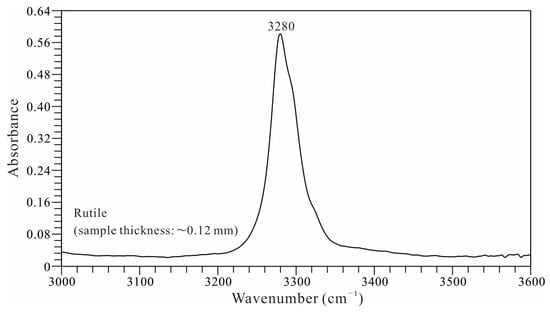
Figure 1.
Infrared spectrum of the rutile sample from ultrahigh-pressure eclogite within subducted continental crust.
The synthesis experiment for TiO2-II utilized a symmetric-type diamond anvil cell (DAC) equipped with a pair of type Ia diamond anvils (culet diameter: ~0.3 mm). A rhenium gasket was pre-indented to a thickness of ~60 μm, and a sample chamber ~0.15 mm in diameter was drilled. Due to the limitations of the sample chamber dimensions, the grains of rutile were crushed into fragments (ranging from 30 to 60 μm in size). For each pressure-induced phase transition experiment, a fragment was loaded into the sample chamber with ruby spheres, and the chamber was backfilled with neon as the pressure-transmitting medium. Based on pressure calibration via the shift of the ruby R1 luminescent line [21], the rutile fragment was first compressed to 18–19 GPa and then gradually decompressed to ambient pressure. During decompression to ambient pressure, the rutile fragment transformed into TiO2-II. To obtain a sufficient quantity of TiO2-II samples (as well as backup samples), this experiment was repeated multiple times. The recovered TiO2-II samples (Figure 2) were subsequently used for further experiments in this study. The infrared spectrum (acquired using the same method as for the rutile sample) of the TiO2-II sample exhibited strong absorption peaks in the 2800–3600 cm−1 region (Figure 3), indicating that water in rutile can be retained in a TiO2-II sample after undergoing a pressure-induced phase transition to TiO2-II.
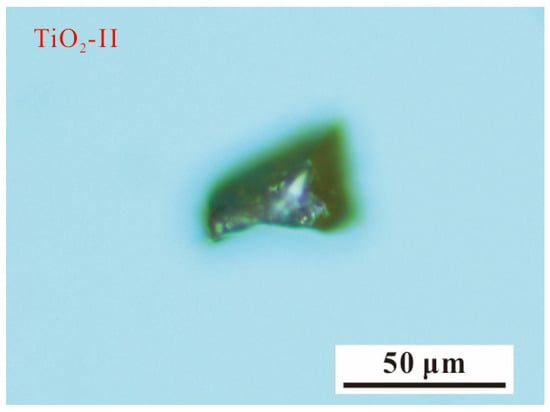
Figure 2.
Photomicrograph of the representative fragment of the TiO2-II sample.
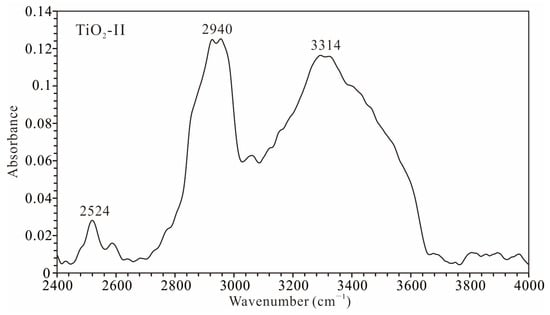
Figure 3.
Infrared spectrum of the TiO2-II sample under ambient pressure conditions.
For high-pressure Raman spectroscopic measurements, a symmetric-type diamond-anvil cell containing a pair of type Ia diamond anvils with 0.3 mm culet diameters was employed to compress the TiO2-II sample. A chip featuring flat surfaces (approximately 40 μm × 30 μm × 30 μm in size), along with two ruby spheres for pressure calibration, was selected and loaded into a rhenium gasket hole measuring 150 μm in diameter and 50 μm in depth. Neon was loaded as a pressure-transmitting medium at 2.56 GPa. Raman spectra were acquired using a WITec confocal Raman imaging microscope (WITec alpha300R) equipped with a 20× microscope objective at Center for High Pressure Science and Technology Advanced Research, Beijing, China. All spectra were measured within the 100 to 1000 cm−1 wavenumber range, utilizing a 1800 gr/mm grating, five accumulations, 10 seconds of exposure time, and 40 mW laser power. Pressure was determined via the ruby R1 fluorescence line shift [21]. The measurements spanned the 2.4 to 38.6 GPa range during both compression and decompression cycles.
For thermal stability analysis, the fragments of TiO2-II were placed on sapphire sheets and subjected to successive half-hour heating treatments in a muffle furnace at 100, 200, 300, 400, 500, 600, 700, 800, and 900 °C. Following each heating cycle, the crystals were removed and subjected to Raman and infrared spectroscopic analyses after cooling to room temperature. Subsequent heating procedures were continued after the analyses were completed. Raman spectra were collected by a WITec confocal Raman imaging microscope (WITec alpha300R) with a 100× microscope objective. All spectra were recorded in the 100 to 1000 cm−1 wavenumber range using a 1800 gr/mm grating, five accumulations, 10 seconds of exposure time, and 30 mW laser power. Infrared spectra were recorded using a Bruker INVENIO-R FTIR spectrometer with a Bruker HYPERION 1000 microscope (20× objective) over the 2400–4000 cm−1 range at Center for High Pressure Science and Technology Advanced Research, Beijing, China. Both background and sample spectra were acquired with 128 scans.
3. Results and Discussion
3.1. High-Pressure Behavior of TiO2-II
The Raman spectrum of the sample obtained from the pressure-induced phase transition experiment under ambient conditions exhibited scattering peaks at 170, 277, 311, 339, 352, 422, 529, and 568 cm−1 (Figure 4). These spectral features match those reported in previous studies for TiO2-II samples synthesized via compression experiments [15], confirming the successful transformation of natural rutile into TiO2-II.
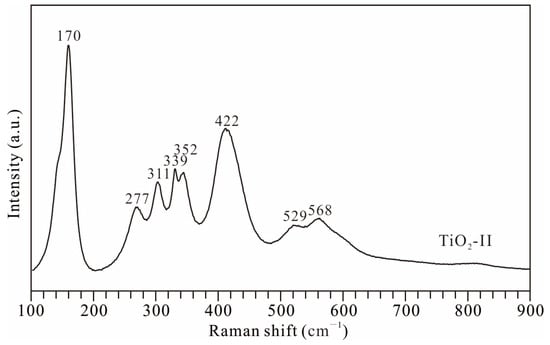
Figure 4.
Raman spectrum of the TiO2-II sample under ambient pressure conditions.
As shown in Figure 5 and Figure 6 and Table S1, within the pressure range from 2.56 to 11.98 GPa, the Raman scattering peaks of the TiO2-II sample exhibit a linear shift toward higher frequencies with increasing pressure. This indicates that although the crystal structure of TiO2-II undergoes compression under high-pressure conditions, it maintains its structural integrity within this pressure range. The Raman spectral characteristics of TiO2-II undergo significant changes when the pressure reaches 15.31 GPa. The linear shift of the original Raman scattering peaks is interrupted, accompanied by the emergence of a series of new scattering peaks represented by strong peaks at 224, 244, 270, and 407 cm−1 (Figure 5 and Figure 6). These modifications signify the initiation of a phase transition from TiO2-II to akaogiite. Upon reaching 16.91 GPa, the Raman spectrum of TiO2-II evolves further, displaying characteristic scattering peaks at 164, 226, 246, 272, 321, 360, 412, 444, 490, 520, 638, 709, and 826 cm−1 (Figure 5 and Figure 6). This confirms the complete transition to akaogiite [2,15].
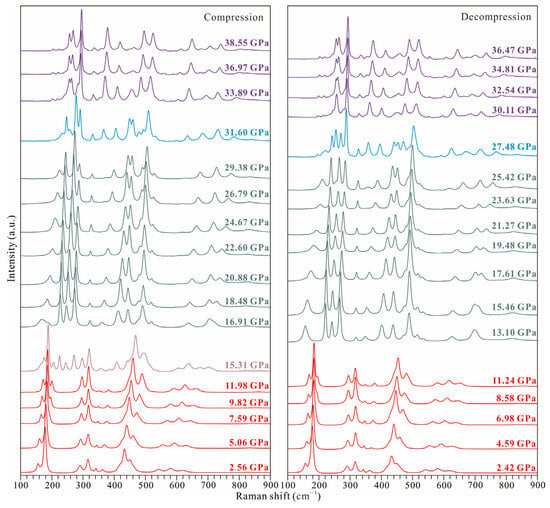
Figure 5.
Raman spectra of the TiO2-II sample as functions of increasing and decreasing pressure.
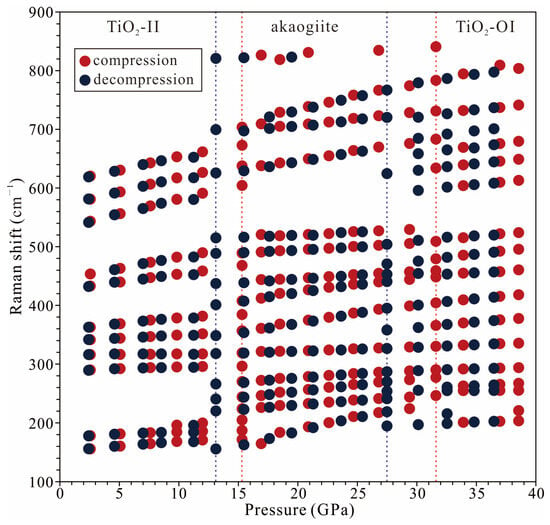
Figure 6.
Variations in band frequencies in the Raman spectra with varying pressure under compression and decompression. The error bars are within the sizes of the symbols.
The in situ high-pressure Raman spectroscopy analysis conducted by Wang et al. [16] on synthetic TiO2-II revealed that an anhydrous TiO2 sample began to transform into akaogiite at approximately 10 GPa. In contrast, samples containing Al and H in their structure required higher pressures for this phase transition to occur. Specifically, the sample with the chemical formula Ti0.96(AlH)0.04O2 initiated the transformation at ~19 GPa, while the sample with the formula Ti0.93(AlH)0.07O2 exhibited no transition to akaogiite within the studied pressure range (0–20 GPa).
In this study, the pressure required for the Al-free TiO2-II sample to begin transforming into akaogiite (12–15 GPa) is significantly lower than that needed for the two previously reported Al-bearing samples to undergo the same phase transition. This also demonstrates that Al substantially elevates the pressure threshold for this transformation. A study by Escudero and Langenhorst [22] on Al incorporation into high-pressure polymorphs of TiO2 (at 10–20 GPa and 1300 °C) demonstrated that Al exhibits lower affinity for akaogiite compared to TiO2-II. This finding may explain how Al extends the stability field of TiO2-II to higher pressures. Furthermore, in the study by Wang et al. [16], the Al-bearing TiO2-II samples were hydrous. Therefore, Al can enter the TiO2-II structure via substitution of Ti4+ by Al3+ coupled with H+. This coupled substitution mechanism can suppress the formation of oxygen vacancies associated with the direct substitution of Ti4+ by Al3+. Such oxygen vacancies may destabilize TiO2-II at higher pressures [22].
The transformation pressure (12–15 GPa) observed for the Al-free TiO2-II sample in this study is notably higher than that (10 GPa) reported by Wang et al. [16]. The size of the TiO2-II crystal (~40 μm) used for high-pressure Raman spectroscopy analysis in this study is comparable with that of the TiO2-II crystals (30–100 μm) used by Wang et al. [16]. The key difference between the TiO2-II sample in this work and the pure TiO2 sample in that of Wang et al. [16] lies in the presence of water (≤0.12 wt% H2O) in our sample. In water-free samples, the presence of a small amount of Ti3+ could result in the simultaneous formation of oxygen vacancies in the crystal structure. In water-bearing samples, however, H+ can partially compensate for the charge imbalance resulting from the reduction of Ti4+ to Ti3+ [23]. Therefore, it is possible that the oxygen vacancies in the water-bearing sample investigated in this study are fewer than those in the previously reported water-free sample. And this may be one of the possible reasons why the water-bearing sample undergoes a phase transition to akaogiite at higher pressures. Whether other factors (such as crystal orientation) can exert similar influence on the pressure conditions for this phase transition requires further experimental investigation (e.g., in situ high-pressure Raman spectroscopy and XRD analysis) to elucidate.
At 31.60 GPa, the Raman spectrum of akaogiite exhibits significant changes, characterized by the appearance of new scattering peaks at 366, 479, and 634 cm−1, indicating the onset of its phase transition to TiO2-OI (Figure 5 and Figure 6). When the pressure reaches 33.89 GPa, the sample’s Raman spectrum shows scattering peaks at 201, 255, 262, 291, 332, 370, 409, 455, 485, 515, 604, 639, 669, 694, 732, and 794 cm−1 (Table S1). These spectral features confirm the complete transformation from akaogiite to TiO2-OI [2]. In the pressure range of 33.89 to 38.55 GPa (the maximum pressure studied), while these peaks continue to shift with increasing pressure, no further significant changes occur in the Raman spectrum characteristics (Figure 5 and Figure 6), suggesting no additional phase transitions within this range.
Previous studies have shown that pure akaogiite retains its crystal structure at pressures of up to 40 GPa [14], whereas Nb-bearing akaogiite begins transforming into TiO2-OI at approximately 33 GPa [2]. The pressure observed in this study for the phase transition from akaogiite to TiO2-OI (31.60 GPa) is close to that required for the transition in Nb-bearing akaogiite (33 GPa). However, considering that the samples reported in the previous studies [2,14] were finely ground powders, the influence of water on this phase transition requires further experiments on water-bearing powdered samples to delineate.
As shown in Figure 5, the Raman spectral characteristics indicate that TiO2-OI maintains its structural integrity at 30.11 GPa during decompression, whereas it exhibits instability at the same pressure during pressurization. Furthermore, akaogiite persists at 13.10 GPa during decompression, though unstable at this pressure during pressurization (Figure 5). This indicates that the pressure conditions required for the two sequential phase transitions of TiO2-II occurring from ambient pressure to 38.55 GPa during pressurization do not fully correspond to those necessary for their respective reversed phase transitions during decompression. Due to reconstructive phase transitions involving the breaking and reconstruction of primary chemical bonds, such transitions require overcoming a substantial thermodynamic barrier [24]. Consequently, initiating the forward transition during compression necessitates overpressure, while initiating the reverse transition during decompression requires underpressure. This pressure asymmetry likely constitutes the primary driver of the observed irreversibility in the phase transition path.
3.2. Thermal Stability of TiO2-II
The Raman spectral features of the TiO2-II samples recovered after heating to 100, 200, 300, 400, and 500 °C remain consistent with those of the untreated sample (Figure 7). The primary scattering peaks of TiO2-II (observed at 170, 277, 311, 339, 352, 422, 529, and 568 cm−1) persisted after heating to 500 °C, with no significant changes in their relative intensities. Furthermore, no new peaks appeared in the Raman spectra of the recovered samples (Figure 7). These results indicate that the TiO2-II sample retained structural stability at temperatures of up to 500 °C under ambient pressure. Compared with the untreated TiO2-II sample, the recovered TiO2-II sample after heating to 600 °C shows significant changes in the Raman spectral features. The Raman spectrum of the recovered sample exhibits three new strong scattering peaks at 255, 436, and 609 cm−1, which are characteristic of the rutile phase [15,16]. These observations indicate that the phase transformation from TiO2-II to rutile initiates within the temperature range of 500–600 °C. In the Raman spectrum of the sample recovered after heating to 700 °C, the scattering peaks (170, 311, 339, and 352 cm−1) previously observed in the Raman spectrum of TiO2-II disappear (Figure 7). This change suggests the completion of the phase transformation from TiO2-II to rutile.
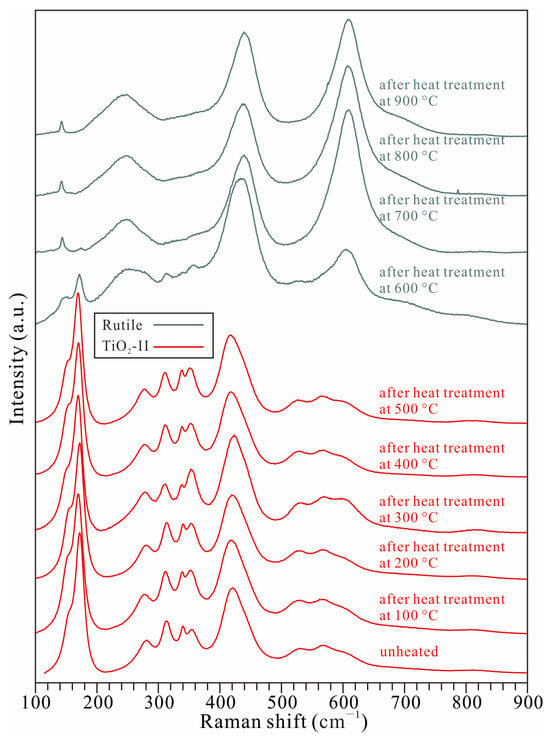
Figure 7.
Raman spectra of heat-treated and untreated TiO2-II samples.
The infrared spectral characteristics of the TiO2-II sample in this study (Figure 3) differ from those reported in previous studies for Al-bearing TiO2-II samples [16]. Although the hydroxyl vibration peak at approximately 2940 cm−1, documented in prior research [16], was also observed in the infrared spectrum of the TiO2-II sample in this study (Figure 3), the spectrum of our sample additionally exhibited a series of broad and strong absorption peaks within the 3000–3600 cm−1 region (Figure 3). In mineral crystal structures, O-H stretching frequencies are governed by O-H···O hydrogen bond lengths. Higher wavenumbers of O-H bands typically correspond to weaker hydrogen bonding, while lower wavenumbers indicate stronger hydrogen bonding [25]. During the synthesis of TiO2-II in this study, the original tetragonal rutile sample undergoes multiple phase transitions under pressure cycling (compression and decompression) to ultimately form the lower-symmetry orthorhombic TiO2-II phase [15]. This process involves the breaking and reconstruction of primary chemical bonds and the rearrangement of hydrogen atoms. Consequently, compared with the hydrogen-bonding configurations within the original rutile, those in the resultant TiO2-II phase are likely more complex. Therefore, the presence of the peak at 2940 cm−1 alongside broad absorptions across 3000–3600 cm−1 suggests that hydroxyl groups occupy multiple nonequivalent sites with distinct hydrogen-bonding environments in the crystal structure.
The infrared spectral features of the water-bearing TiO2-II recovered after heating to 100, 200, and 300 °C remained consistent with those of the untreated sample (Figure 8). After heating to 400 °C, the vibrational peak at 2900–3000 cm−1 disappeared, while the peaks in the range of 3000–3600 cm−1 persisted. This demonstrates that hydroxyl groups at different positions within the TiO2-II crystal structure exhibit varying thermal stability. After the phase transformation of TiO2-II to rutile (after heating to 600 °C), the peaks in the 3000–3600 cm−1 range remained visible (Figure 8). However, their peak heights decreased after heating to 700 °C, indicating dehydration of the sample. After heating to 900 °C, the infrared spectrum of the sample was characterized by a relatively sharp vibrational peak at 3290 cm−1 (Figure 8). The position of this peak aligns with the hydroxyl vibrational band observed in the infrared spectra of the natural rutile samples used in this study (Figure 2) and those reported in previous studies [23,26].
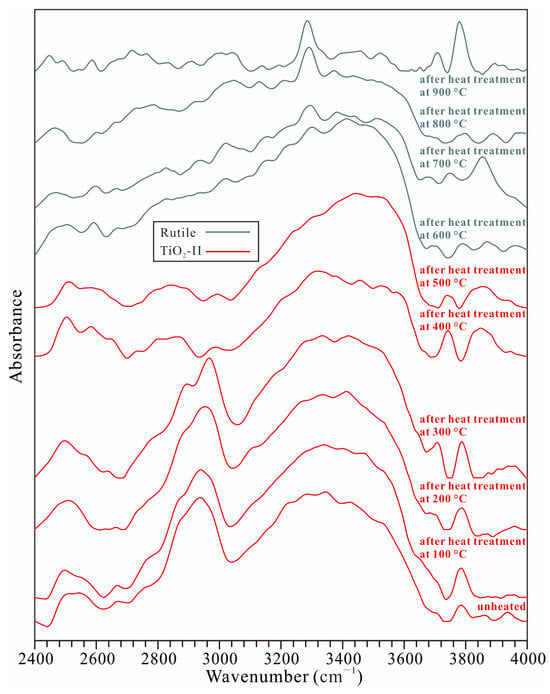
Figure 8.
Infrared spectra of heat-treated and untreated TiO2-II samples.
High-temperature Raman spectroscopy analysis by Wang et al. [16] on synthesized TiO2-II samples revealed that, under ambient pressure, anhydrous pure TiO2 samples undergo a phase transition to rutile at 730 °C. By comparison, the temperature required for the phase transition to rutile of the water-bearing TiO2-II sample in this study (500–600 °C) is significantly lower (Figure 7). This implies that water (hydrogen) incorporated into TiO2-II can alter the temperature conditions for the TiO2-II-to-rutile phase transition. According to Wang et al. [16], hydrous Al-bearing TiO2-II samples transformed into rutile at approximately 630–680 °C. Prior to this phase transition, the samples underwent dehydration within a temperature range of approximately 530–630 °C. This dehydration process was marked by a significant decrease in the intensity of the OH band, which was located at 2900–3000 cm−1 at room temperature. Similarly, the Al-free TiO2-II sample investigated in this study underwent partial dehydration at 300–400 °C before the phase transition (500–600 °C). This dehydration is characterized by the disappearance of the OH band at about 2900–3000 cm−1 (Figure 8). This indicates that under high-temperature conditions, dehydration may exert a more pronounced effect on the stability of TiO2-II than Al content does.
The high-pressure polymorphs of SiO2 are key components in subducted oceanic crust and serve as important carriers of water (hydrogen), transporting it into Earth’s deep interior [27,28]. α-PbO2-type SiO2 (seifertite), which shares the same structure as TiO2-II [29,30], is likely the dominant SiO2 polymorph existing at the base of the lower mantle (110–130 GPa). The experimental results from this study suggest that the potential implications of water (hydrogen) incorporation in seifertite on its thermal stability should be fully considered in future investigations regarding the form of SiO2 at the base of the lower mantle.
4. Conclusions
- (1)
- At room temperature, water-bearing TiO2-II (with water content of up to 0.12 wt% H2O) transitions to akaogiite at pressures of approximately 12–15 GPa. Although this transition pressure is lower than the values previously reported for hydrous Al-bearing samples (>19 GPa), it is higher than those reported for anhydrous pure TiO2 samples (10 GPa). This suggests that water (hydrogen) can affect the pressure stability of TiO2-II.
- (2)
- Hydroxyl groups at distinct sites within the crystal structure of the TiO2-II sample display differing thermal stabilities. Although the sample underwent partial dehydration between 300 and 400 °C under atmospheric pressure, marked by the disappearance of the ~2900–3000 cm−1 OH band, the majority of the hydroxyl content persisted at higher temperatures (even after the phase transition from TiO2-II to rutile).
- (3)
- The transition temperature from water-bearing TiO2-II to rutile observed in this study is at least 130 °C lower than that reported for anhydrous pure TiO2-II and markedly lower than that for hydrous Al-bearing TiO2-II. The dehydration or partial dehydration of the water-bearing TiO2-II during heating may be the underlying reason for the phase transition from TiO2-II to rutile occurring at a lower temperature.
Supplementary Materials
The following supporting information can be downloaded at: https://www.mdpi.com/article/10.3390/cryst15080720/s1, Figure S1: Chemical composition analysis result of the rutile sample from ultrahigh-pressure eclogite within subducted continental crust; Table S1: frequencies (cm−1) of the bands in the spectra from in situ high-pressure Raman spectroscopic measurements of TiO2-II.
Author Contributions
L.Z. suggested the basis of this paper; X.L. and L.Z. wrote this paper; X.L. and S.Q. performed high-pressure Raman spectroscopic measurements; X.L., J.L., S.Q., and Y.C. performed the infrared spectroscopic measurements; Y.O. performed the EDS analysis; and Y.O. and M.F. performed the thermal stability analysis. All authors have read and agreed to the published version of the manuscript.
Funding
This study was supported by the National Natural Science Foundation of China (No. 42172044).
Data Availability Statement
The original contributions presented in the study are included in the article and supplementary material, further inquiries can be directed to the corresponding author.
Conflicts of Interest
The authors declare no conflicts of interest.
References
- Al-Khatatbeh, Y.; Lee, K.K.M.; Kiefer, B. High-pressure behavior of TiO2 as determined by experiment and theory. Phys. Rev. B 2009, 79, 134114. [Google Scholar] [CrossRef]
- Liu, W.; Chen, J.; Zhang, X.; Yan, J.; Hou, M.; Kunz, M.; Zhang, D.; Zhang, H. Pressure-induced phase transitions of natural brookite. ACS Earth Space Chem. 2019, 3, 844–853. [Google Scholar] [CrossRef]
- Dachille, F.; Simons, P.Y.; Roy, R. Pressure-temperature studies of anatase, brookite, rutile and TiO2-II. Am. Mineral. 1968, 53, 1929–1939. [Google Scholar]
- Vlassopoulos, D.; Rossman, G.R.; Haggerty, S.E. Coupled substitution of H and minor elements in rutile and the implications of high OH contents in Nb- and Cr-rich rutile from the upper mantle. Am. Mineral. 1993, 78, 1181–1191. [Google Scholar]
- Johnson, E.A. Water in nominally anhydrous crustal minerals: Speciation, concentration, and geologic significance. Rev. Mineral. Geochem. 2006, 62, 117–154. [Google Scholar] [CrossRef]
- Yang, Y.; Xia, Q.; Feng, M.; Gu, X. In situ FTIR investigations at varying temperatures on hydrous components in rutile. Am. Mineral. 2011, 96, 1851–1855. [Google Scholar] [CrossRef]
- Jamieson, J.C.; Olinger, B. High-pressure polymorphism of titanium dioxide. Science 1968, 161, 893–895. [Google Scholar] [CrossRef]
- Sato, H.; Endo, S.; Sugiyama, M.; Kikegawa, T.; Shimomura, O.; Kusaba, K. Baddeleyite-type high-pressure phase of TiO2. Science 1991, 251, 786–788. [Google Scholar] [CrossRef]
- Dubrovinskaia, N.A.; Dubrovinsky, L.S.; Ahuja, R.; Prokopenko, V.B.; Dmitriev, V.; Weber, H.-P.; Osorio-Guillen, J.M.; Johansson, B. Experimental and theoretical identification of a new high-pressure TiO2 polymorph. Phys. Rev. Lett. 2001, 87, 275501. [Google Scholar] [CrossRef] [PubMed]
- El Goresy, A.; Chen, M.; Gillet, P.; Dubrovinsky, L.; Graup, G.; Ahuja, R. A natural shock-induced dense polymorph of rutile with α-PbO2 structure in the suevite from the Ries crater in Germany. Earth Planet. Sci. Lett. 2001, 192, 485–495. [Google Scholar] [CrossRef]
- Dawei, M.; Xiuling, W.; Xiaoyu, F.; Zhengjie, Z.; Hong, C.; Xin, M.; Jianping, Z. High pressure response of rutile polymorphs and its significance for indicating the subduction depth of continental crust. Acta Geol. Sin. 2008, 82, 371–376. [Google Scholar] [CrossRef]
- Wu, X.; Meng, D.; Han, Y. α-PbO2-Type Nanophase of TiO2 from Coesite-bearing eclogite in the dabie mountains, China. Am. Mineral. 2005, 90, 1458–1461. [Google Scholar] [CrossRef]
- Gerward, L.; Staun Olsen, J. Post-rutile high-pressure phases in TiO2. J. Appl. Cryst. 1997, 30, 259–264. [Google Scholar] [CrossRef]
- Swamy, V.; Dubrovinskaia, N.A.; Dubrovinsky, L.S. Compressibility of baddeleyite-type TiO2 from static compression to 40 GPa. J. Alloys Compd. 2002, 340, 46–48. [Google Scholar] [CrossRef]
- Lu, X.; Gao, S.; Wu, P.; Zhang, Z.; Zhang, L.; Li, X.; Qin, X. In situ high-pressure raman spectroscopic, single-crystal X-ray diffraction, and FTIR investigations of rutile and TiO2II. Minerals 2023, 13, 703. [Google Scholar] [CrossRef]
- Wang, S.; Wang, Q.; Ye, Y.; Liu, D.; Zhu, X.; Hu, Y.; Miao, Y.; Wu, Z.; Pan, Y. Al3+ and H+ substitutions in TiO2 polymorphs: Structural and vibrational investigations. Am. Mineral. 2025, 110, 241–254. [Google Scholar] [CrossRef]
- Zhang, Z.; Xiao, Y.; Hoefs, J.; Liou, J.G.; Simon, K. Ultrahigh pressure metamorphic rocks from the Chinese Continental Scientific Drilling Project: I. Petrology and geochemistry of the main hole (0–2050 m). Contrib. Mineral. Petrol. 2006, 152, 421–441. [Google Scholar] [CrossRef]
- Maldener, J.; Rauch, F.; Gavranic, M.; Beran, A. OH absorption coefficients of rutile and cassiterite deduced from nuclear reaction analysis and FTIR spectroscopy. Miner. Petrol. 2001, 71, 21–29. [Google Scholar] [CrossRef]
- Libowitzky, E.; Rossman, G.R. An IR absorption calibration for water in minerals. Am. Mineral. 1997, 82, 1111–1115. [Google Scholar] [CrossRef]
- Purevjav, N.; Fei, H.; Ishii, T.; Criniti, G.; Lin, Y.; Mao, H.-K.; Katsura, T. Temperature dependence of H2O solubility in Al-free stishovite. Geophys. Res. Lett. 2024, 51, e2023GL104029. [Google Scholar] [CrossRef]
- Mao, H.K.; Xu, J.; Bell, P.M. Calibration of the ruby pressure gauge to 800 kbar under quasi-hydrostatic conditions. J. Geophys. Res. 1986, 91, 4673–4676. [Google Scholar] [CrossRef]
- Escudero, A.; Langenhorst, F. Aluminum incorporation in α-PbO2 type TiO2 at pressures up to 20 GPa. Phys. Earth Planet. Inter. 2012, 190–191, 87–94. [Google Scholar] [CrossRef]
- Guo, H. In-situ infrared spectra of OH in rutile up to 1000 °C. Phys. Chem. Miner. 2017, 44, 547–552. [Google Scholar] [CrossRef]
- Liu, M.; Wang, J.; Hu, J.; Liu, P.; Niu, H.; Yan, X.; Li, J.; Yan, H.; Yang, B.; Sun, Y.; et al. Layer-by-layer phase transformation in Ti3O5 revealed by machine-learning molecular dynamics simulations. Nat. Commun. 2024, 15, 3079. [Google Scholar] [CrossRef]
- Libowitzky, E. Correlation of O-H stretching frequencies and O-H…O hydrogen bond lengths in minerals. Monatsh. Chem. 1999, 130, 1047–1059. [Google Scholar] [CrossRef]
- Bromiley, G.D.; Hilairet, N. Hydrogen and minor element incorporation in synthetic rutile. Mineral. Mag. 2005, 69, 345–358. [Google Scholar] [CrossRef]
- Hirose, K.; Takafuji, N.; Sata, N.; Ohishi, Y. Phase Transition and density of subducted MORB crust in the lower mantle. Earth Planet. Sci. Lett. 2005, 237, 239–251. [Google Scholar] [CrossRef]
- Lin, Y.; Mao, H.-K. Dense hydrous silica carrying water to the deep Earth and promotion of oxygen fugacity heterogeneity. Matter Radiat. Extremes 2022, 7, 068101. [Google Scholar] [CrossRef]
- Nomura, R.; Hirose, K.; Sata, N.; Ohishi, Y. Precise determination of post-stishovite phase transition boundary and implications for seismic heterogeneities in the mid-lower mantle. Phys. Earth Planet. Inter. 2010, 183, 104–109. [Google Scholar] [CrossRef]
- Tsutsumi, Y.; Sakamoto, N.; Hirose, K.; Tagawa, S.; Umemoto, K.; Ohishi, Y.; Yurimoto, H. Retention of water in subducted slabs under core–mantle boundary conditions. Nat. Geosci. 2024, 17, 697–704. [Google Scholar] [CrossRef]
Disclaimer/Publisher’s Note: The statements, opinions and data contained in all publications are solely those of the individual author(s) and contributor(s) and not of MDPI and/or the editor(s). MDPI and/or the editor(s) disclaim responsibility for any injury to people or property resulting from any ideas, methods, instructions or products referred to in the content. |
© 2025 by the authors. Licensee MDPI, Basel, Switzerland. This article is an open access article distributed under the terms and conditions of the Creative Commons Attribution (CC BY) license (https://creativecommons.org/licenses/by/4.0/).